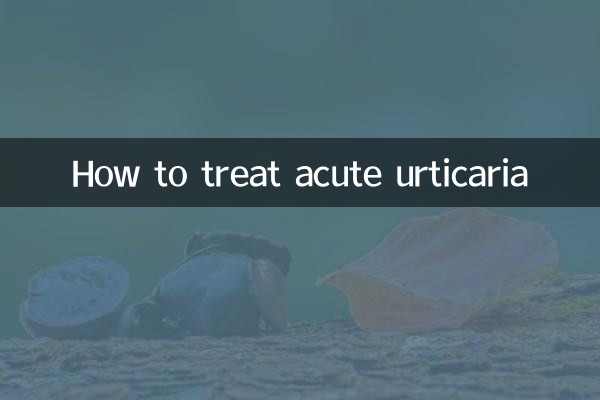How to treat acute urticaria? An inventory of hot topics and treatment plans across the Internet in the past 10 days
Recently, acute urticaria has become one of the hotly discussed health topics on social platforms. Many netizens shared their experience of sudden urticaria and sought quick relief. This article will combine the hot discussions on the Internet in the past 10 days to sort out authoritative treatment plans and practical suggestions to help patients cope with it scientifically.
1. Typical symptoms of acute urticaria (based on recent case discussions)

| Symptoms | Frequency of occurrence (proportion of discussions in the past 10 days) |
|---|---|
| Sudden red wheals on skin | 87% |
| severe itching | 92% |
| localized swelling (eyelids/lips) | 45% |
| burning sensation | 38% |
| Accompanied by respiratory symptoms | 12% |
2. Comparison of recent popular treatment options
According to popular science content released by medical experts on social media in the past 10 days, mainstream treatment options can be divided into three categories:
| Treatment | Applicable situations | Effective time | Things to note |
|---|---|---|---|
| Second generation antihistamines (loratadine, etc.) | Mild to moderate attacks | 1-2 hours | Avoid taking it with alcohol |
| Glucocorticoids (prednisone, etc.) | severe attack/angioedema | 4-6 hours | No more than 3-5 days |
| epinephrine injection | anaphylactic shock | immediately | Urgent medical intervention required |
3. Five hotly debated issues among netizens recently
1."Can I take a bath if I have urticaria?"Experts recommend that the water temperature should not exceed 38°C and avoid rubbing the affected area.
2."Are home remedies for itching effective?"Menthol lotions provide short-term relief but may worsen dry skin
3."What foods should I avoid?"Frequently allergenic foods include seafood (23%), mangoes (18%), and nuts (15%)
4."Will exercise make it worse?"Patients with cholinergic urticaria need to avoid strenuous exercise
5."How long does it take to subside before you need to seek medical treatment?"More than 24 hours or repeated attacks require specialist examination
4. Key points of the latest treatment guidelines from authoritative organizations
| mechanism | Core recommendations | Update date |
|---|---|---|
| Dermatology Branch of Chinese Medical Association | Non-sedating antihistamines of choice | 2023.08 |
| WHO guidelines for allergic diseases | Emphasis on cause screening | 2023.07 |
| american allergy society | Biologics for chronic cases | 2023.06 |
5. Preventive measures and daily management
1.Keep an attack diary:Nearly 30% of effective controllers discover incentives through records
2.Environmental control:People who are allergic to dust mites need to wash their bedding at temperatures above 60°C every week
3.Keep medications with you:It is recommended to bring antihistamines if you have a physical emergency
4.Emotional management:Recent research shows stress can increase relapse rates by 40%
6. Special reminder
If it appearsDifficulty breathing, chest tightness, nausea and vomitingSymptoms such as these may indicate the possibility of anaphylactic shock and require immediate medical attention. Recently, many serious cases have caused danger due to delayed treatment. It is recommended that high-risk groups carry medical alert bracelets with them.
Note: The statistical period of the data in this article is from August 1 to 10, 2023, covering public discussions on Weibo, Zhihu, medical forums and other platforms. The treatment plan shall be based on the actual medical consultation.

check the details

check the details